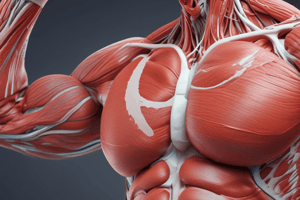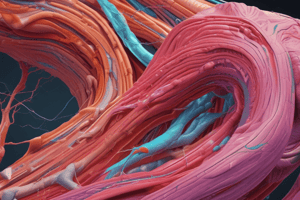Podcast
Questions and Answers
Which type of muscle tissue is multinucleated and peripherally located?
Which type of muscle tissue is multinucleated and peripherally located?
- Skeletal muscles (correct)
- Cardiac muscles
- Smooth muscles
- None of the above
Where are smooth muscles found in the body?
Where are smooth muscles found in the body?
- Attached to bones of the skeleton
- Heart
- Blood vessels
- Gastrointestinal, urinary, and respiratory tracts (correct)
Which type of muscle tissue is centrally located and contains a single nucleus?
Which type of muscle tissue is centrally located and contains a single nucleus?
- Smooth muscles (correct)
- Cardiac muscles
- Skeletal muscles
- None of the above
Which type of muscle tissue is found in the heart?
Which type of muscle tissue is found in the heart?
Which type of muscle tissue is attached to bones of the skeleton?
Which type of muscle tissue is attached to bones of the skeleton?
Compare and contrast the structure and function of skeletal muscles and smooth muscles.
Compare and contrast the structure and function of skeletal muscles and smooth muscles.
Explain the function of smooth muscles and where they are found in the body.
Explain the function of smooth muscles and where they are found in the body.
Describe the structure and function of cardiac muscles.
Describe the structure and function of cardiac muscles.
Differentiate between voluntary and involuntary muscles, providing examples for each.
Differentiate between voluntary and involuntary muscles, providing examples for each.
Explain the structural differences between skeletal muscles and smooth muscles.
Explain the structural differences between skeletal muscles and smooth muscles.
Flashcards are hidden until you start studying
Study Notes
Characteristics of Muscle Types
- Multinucleated and peripherally located muscle tissue is skeletal muscle.
- Smooth muscles are found in the walls of hollow organs, such as the digestive tract, blood vessels, and airways.
- Centrally located muscle tissue with a single nucleus is smooth muscle.
- Cardiac muscle tissue is found in the heart.
Function of Smooth Muscles
- Smooth muscles are involved in involuntary movements, such as contractions of the digestive tract and airways.
- They are found in the walls of hollow organs and help to move substances through these organs.
Cardiac Muscles
- Cardiac muscle tissue is found in the heart and is involved in pumping blood throughout the body.
- Cardiac muscles are striated, but they are involuntary, meaning that they are not under conscious control.
Voluntary and Involuntary Muscles
- Voluntary muscles are under conscious control and are typically skeletal muscles attached to bones.
- Examples of voluntary muscles include the biceps and quadriceps.
- Involuntary muscles are not under conscious control and are typically smooth muscles or cardiac muscles.
- Examples of involuntary muscles include the muscles in the digestive tract and the heart.
Structural Differences
- Skeletal muscles have a striated appearance with multiple nuclei per cell.
- Smooth muscles have a non-striated appearance with a single nucleus per cell.
- Cardiac muscles have a striated appearance, but they are involuntary and have a single nucleus per cell.
Studying That Suits You
Use AI to generate personalized quizzes and flashcards to suit your learning preferences.




